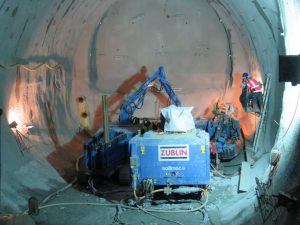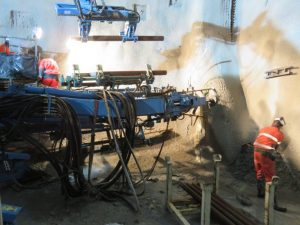There are many strange sayings. “Early to bed and early to rise – makes a man healthy, wealthy and wise” for example – farmers, however, are usually no wealthier than the rest of us, no matter how often they rise at 4 a.m. to milk the cows. “Under an old hat is often a smart head”? No sir, not at all, since “there’s no fool like an old fool.” Similar is true for the saying “to let things loose” – because this makes absolutely no sense when talking about fighting dogs, pipe breaks, or down-hill races. Even when talking about drilling, the builder would not just dig blindfolded through the mountain in serpentines.
Hence, great that there is controlled drilling.
Controlled drilling (also called directional drilling) means that the direction of a deep-drill can be altered and adapted. Especially in variable geology, the quality of the drill needs to be guaranteed and secured. Therein, the drilling process is directly influenced via direction inputs. The technology keeps developing and improving to withstand the growing demands for precision.
In course of the construction site Semmering base tunnel, where many controlled drills are done, we have met Paul Rohm, civil engineer and site manager at Züblin Spezialtiefbau GesmbH. As a young, ambitious engineer he highly values modern improvements and updates of building processes and documentation – hence, we could simplify his daily work life with eguana SCALES and take some documentation-burden off his shoulders.
The advantages of controlled drilling and how it is used, are discussed in the following article by Paul Rohm:
Trend-setting directional drilling
Thanks to the use of controlled drilling, it is possible to increase the achievable drilling distance with consistent precision. Nevertheless, the fact that the appropriate and effective employment of this method is linked to certain geological and process conditions, is neglected.
These drills are of such a kind which is defined by a certain course and target. This target – i.e. deviations of the planed course of the drilling hole – have been formulated and defined more and more precise in recent years. To meet these predefined standards, passive measures as well as active measures for the manipulation of the drilling hole course need to be set for controlled drillings. The active measures are targeted changes of direction during the drilling process (i.e. the drilling direction of piped drills can be changed by non-rotation of the piping).
While with the passive measures an influence on the directionality of the drilling is only possible before the start of drilling, – through the best possible calibration of the drill carriage by geodetic total stations and measuring mirrors, which are mounted in the drilling axis on the carriage – the active measures can influence the drilling hole course during the drilling process.

Active influence on the drilling processes
In order to influence the controlled drill actively during the drilling process, it is essential to know the course of the drill. To do so, it is necessary to be able to measure the holes with a measuring probe. Due to this process, the drill set must be matched to the measuring probe used. The measuring methods of the probes differ between manufacturers, however, care must be taken with each measurement to the respective measurement inaccuracy of the probe. Depending on the drilling method, the measurement of the drilling can be continuous or discontinuous.
In the case of imminent deviations, the direction of the drill can be amended and adjusted to the course defined in the planning by the different, process-specific control units. Additionally, the interpretation of the drilling parameters can significantly influence the course. The combination of drilling progress and flushing pressure makes it possible to indirectly infer the upcoming geology.
Flushing pressure and drilling progress
In areas with little flushing pressure and high drilling progress (a sign for soft rock formation that suffers from erosion), a planned direction adjustment might lead to a worsening since the soft rock formation does not pose a sufficient abutment for a course correction. On the other side, in areas with strong flushing pressure and low drilling progress (a sign for compact geology and solid rock), a course correction can be done actively.
Controlled drillings can be carried out as core drillings as well as destructive drillings. Core drillings are done with rope-core-tubes and are usually used at large construction projects to explore the geology. In the destructive drilling, both piped and un-piped drillings are done. Depending on the drilling method, different control units are used. While in the case of piped drills, the control unit is usually mounted on the piping or the piping itself is set up as control unit, a drilling turbine is used for un-piped drillings.
In the course of the joint project at the Semmering base tunnel, the drilling parameters of the different measuring probes during various drillings were recorded and consequently, analysed and evaluated with the help of eguana SCALES.

Guest author: DI Paul Rohm
Paul Rohm started his career in the construction industry already in 2008 as an intern at Kostmann GesmbH in road construction. Five years later, his master thesis brought him to Züblin Spezialtiefbau GesmbH. The graduate civil engineer specialised in geotechnical engineering and construction management at the University of Technology Vienna, and has since then been active in various projects as construction site manager. His longest project so far, the Semmering base tunnel, has occupied him since 2015.
Many thanks to Paul Rohm for his article. We are looking forward to future collaborations with him and Züblin Spezialtiefbau GesmbH.
If you would like to know more about the construction project at Semmering, click here.
More information about controlled drilling is provided on the following pages:
https://en.wikipedia.org/wiki/Directional_drilling
https://petrowiki.org/Directional_drilling
https://www.rigzone.com/training/insight.asp?insight_id=295&c_id=
